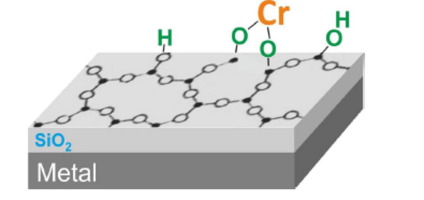Journal of Catalysis ( IF 7.3 ) Pub Date : 2017-11-16 , DOI: 10.1016/j.jcat.2017.10.026 Qiushi Pan , Linfei Li , Shamil Shaikhutdinov , Hans-Joachim Freund

|
The Phillips catalyst (Cr/SiO2) is successfully used in the large-scale production of polyethylene and has attracted a great interest in catalytic community over the last sixty years. However, the atomic structure of the active site(s) and the reaction mechanism remain controversial, in particular due to the structural complexity and surface heterogeneity of the amorphous silica. In this work, we used a well-defined, atomically flat silicate bilayer film grown on Ru(0001) as a support offering the opportunity to investigate mechanistic aspects at the atomic scale. To fabricate a planar Cr/SiO2 model system suitable for surface science studies, chromium was deposited using physical vapor deposition onto the hydroxylated silica film surface. Structural characterization and adsorption studies were performed by infrared reflection absorption spectroscopy (IRAS) and temperature programmed desorption (TPD). Hydroxyls groups seem to serve as anchoring cites to Cr ad-atoms. As monitored by IRAS, hydroxyls consumption correlated with the appearance of the new band at ∼1007 cm−1 typical for CrO vibrations. In addition, CO titration experiments suggested also the presence of “naked” Cr, which transforms into mono- and di-oxo chromyl species and their aggregation upon oxidation treatments. TPD experiments of ethylene adsorption at low temperatures under UHV conditions showed the formation of butane as one of the main products. The resultant surfaces are thermally stable, at least, up to 400 K which allows to investigate ethylene polymerization further under more realistic conditions.
中文翻译:

基于清晰定义的薄硅酸盐薄膜的菲利普斯(Cr / SiO 2)催化剂的平面模型系统
Phillips催化剂(Cr / SiO 2)已成功用于大规模生产聚乙烯,并且在过去60年中引起了催化界的极大兴趣。然而,特别是由于无定形二氧化硅的结构复杂性和表面异质性,活性位点的原子结构和反应机理仍存在争议。在这项工作中,我们使用了生长在Ru(0001)上的清晰定义的原子平坦的硅酸盐双层薄膜作为支撑物,从而提供了在原子尺度上研究机械特性的机会。制作平面Cr / SiO 2在适用于表面科学研究的模型系统中,铬是通过物理气相沉积法沉积在羟基化二氧化硅薄膜表面上的。通过红外反射吸收光谱(IRAS)和程序升温脱附(TPD)进行结构表征和吸附研究。羟基似乎充当了Cr原子的锚定位置。如IRAS所监测,在Cr的约1007 cm -1处,羟基的消耗与新谱带的出现有关O振动。此外,CO滴定实验还表明存在“裸” Cr,该铬可转化为单-和二-氧代铬基物种,并且在氧化处理后会发生聚集。TPD乙烯在超高压条件下的低温吸附实验表明,丁烷的形成是主要产物之一。所得的表面是热稳定的,至少高达400 K,这使得可以在更实际的条件下进一步研究乙烯的聚合反应。



























 京公网安备 11010802027423号
京公网安备 11010802027423号